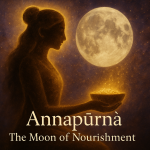How the oil you choose transforms your atmosphere, energy, and inner state.
What if the simple act of lighting a lamp could cleanse your air, calm your mind, and uplift your spirit?
Both ancient seers and modern science agree — the oil you choose for your diya does far more than keep a flame alive. It shapes the energy, chemistry, and vibration of your entire space.
A diya isn’t just an ornament of devotion — it’s a living field of resonance. When the flame dances steadily, your nervous system begins to synchronize with its rhythm. The warmth softens tension. The ions purify the air. The light recalibrates your mood and focus.
In that moment, you’re not just lighting a lamp — you’re igniting harmony between matter and spirit.
Let’s explore the most common oils used in diyas, and how each one influences your environment and consciousness — through the twin lenses of science and spirituality.
🪔 What Are Diyas and Why Are Oils Important?
A diya represents the eternal triumph of light over darkness, knowledge over ignorance, and truth over illusion. In every ritual, the diya acts as a bridge between the material and the divine—its flame symbolizing the soul’s journey toward enlightenment.
The oil is not merely fuel; it is the offering—the substance that sustains illumination. The choice of oil determines the purity, clarity, and frequency of that light.
🌿 Common Oils Used in Diyas
1. Ghee (Clarified Butter)
Scientific View:
Ghee burns with a bright, clean flame and produces minimal smoke. Studies show that the combustion of ghee releases beneficial negative ions that help purify the air, neutralize toxins, and promote mental calmness.
Spiritual View:
Ghee is considered the most sattvic (pure) of all substances. A ghee diya attracts divine vibrations, dispels negativity, and enhances spiritual radiance. It is the preferred choice for major pujas, homas, and Lakshmi worship—signifying abundance and grace.
2. Sesame Oil (Til Oil)
Scientific View:
Sesame oil has natural antimicrobial properties and burns with a steady, stable flame, creating a balanced energetic field.
Spiritual View:
In Ayurveda and Tantra, sesame oil removes doshas (imbalances) and negative influences. Lighting a sesame oil diya grounds your energy, strengthens prana, and enhances mental clarity and resilience. Traditionally used in Bhairava and ancestral rituals, it invokes protection and balance.
3. Mustard Oil
Scientific View:
Mustard oil emits a robust, golden flame and acts as a natural disinfectant, purifying the air and deterring insects. Its pungent vapors can support respiratory health and sterilize the environment.
Spiritual View:
Associated with Saturn (Shani), mustard oil lamps are used to dissolve karmic blocks and protect from negative energies. The pungent aroma symbolizes perseverance, endurance, and transformation, making it ideal for Vastu balancing and Shani pujas.
4. Coconut Oil
Scientific View:
Coconut oil burns almost smokeless and releases a gentle, pleasant aroma. It provides a clean, long-lasting flame, making it ideal for indoor use.
Spiritual View:
Highly revered in South Indian temples, coconut oil represents innocence, purity, and surrender. Lighting a coconut oil diya is said to please Lord Ganesha and bring peace, prosperity, and divine blessings to the home.
5. Castor Oil & Mahua Oil
Scientific View:
Castor oil burns with a bright, enduring flame, while mahua oil, derived from the Madhuca longifolia tree, is eco-friendly and generates minimal smoke.
Spiritual View:
Castor oil is believed to attract wealth and auspiciousness, while mahua oil—often used in tribal and village traditions—signifies harmony with nature and divine grace. These oils are often blended in special or seasonal rituals to invoke abundance and ecological balance.
🔬 Scientific Benefits of Lighting Diyas
Air Purification: Natural oils like ghee and sesame release negative ions that neutralize airborne toxins and microbes.
Mood Regulation: The warm glow and subtle aroma of a diya can reduce stress, steady the breath, and enhance focus.
Cleaner Environment: Unlike synthetic candles, natural oils burn cleanly, producing less soot and smoke, improving indoor air quality.
✨ Spiritual Significance of the Flame
Invoking Divine Presence: Every diya becomes a portal of auspicious energy, inviting prosperity and protection.
Removing Negativity: The radiant flame is believed to absorb dense vibrations, transmuting them into light.
Balancing Energies: Diyas harmonize the five elements (Pancha Bhootas)—earth, water, fire, air, and ether—restoring environmental and emotional balance.
Meditative Focus: A steady flame draws the gaze inward, quieting the mind and awakening inner clarity.
🪔 Comparison Table: Oils for Diyas
| Oil Type | Scientific Benefits | Spiritual Benefits | Ritual Uses |
|---|---|---|---|
| Ghee | Bright, clean, purifies air | Purity, prosperity, divine blessings | Major pujas, Lakshmi worship |
| Sesame Oil | Antimicrobial, steady burn | Removes doshas, promotes clarity | Bhairava puja, daily rituals |
| Mustard Oil | Robust flame, repels microbes | Saturn dosha reduction, protection | Vastu rituals, Shani puja |
| Coconut Oil | Smokeless, fragrant | Peace, purity, prosperity | South Indian rituals, Ganesha puja |
| Castor Oil | Bright, long-lasting | Attracts wealth, auspiciousness | Special pujas, prosperity rituals |
| Mahua Oil | Eco-friendly, steady flame | Harmony, ecological balance | Tribal & rural rituals, seasonal use |
🌼 Conclusion
Lighting a diya is more than a symbolic act—it’s a ritual of inner alignment.
The oil you choose becomes an offering not only to the Divine but also to your own consciousness.
A ghee flame purifies your thoughts.
A sesame lamp stabilizes your energy.
A mustard diya protects your space.
A coconut flame invites peace and grace.
When you light a diya with awareness, you are kindling your inner light—transforming your environment, emotions, and energy field.
✨ Let every flame you light be an act of remembrance—of your own radiant essence and the eternal light within. ✨









